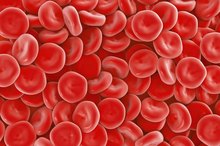Complications of a Low Platelet Count
The main job of platelets is to make blood sticky so that it can form clots. This is important when you are injured so that you do not bleed to death. When you bleed, platelets swarm to the area and attempt to stop the blood flow. This in turn allows scabs to form, whether on the surface of the skin or internally which appears as bruising. If you notice the signs and symptoms of a low platelet count, your doctor can do a routine blood test to determine if your platelet count is low and then take the necessary steps to avoid complications.
Mild Thrombocytopenia
The National Institutes of Health, or NIH, states that a normal platelet count is between 150,000 to 400,000 platelets per microliter of blood 1. Numbers below this are considered abnormally low and signify that there may be disease. The medical term for a low platelet count is thrombocytopenia 4. Mild cases of this condition usually produce no long-lasting results. However, in some cases -- platelet counts of 10,000 to 50,000 -- you may experience symptoms such as bruising easily, nosebleeds and bleeding in the mouth or gums. You may notice blood in your stool or urine, your menstrual periods may be heavier then normal or you may develop a rash called petechiae, which is identified by very small red spots all over the skin. The NIH reports that in most cases, the complications that occur with this condition are associated with the underlying disease that is causing your platelet count to drop.
- The National Institutes of Health, or NIH, states that a normal platelet count is between 150,000 to 400,000 platelets per microliter of blood 1.
- The NIH reports that in most cases, the complications that occur with this condition are associated with the underlying disease that is causing your platelet count to drop.
Excessive Blood Loss
Causes of High MPV Blood
Learn More
If you have a more severe case of thrombocytopenia, you are at risk for excessive bruising and bleeding with minor cuts or injuries 4. Even the smallest injury can become life threatening. According to The Merck Manuals Online Library the most serious risk of bleeding occurs when the platelet count falls below 10,000 to 20,000 platelets per microliter. If your platelet count falls to very low levels, you may start to bleed internally, perhaps losing blood through your digestive system.
- If you have a more severe case of thrombocytopenia, you are at risk for excessive bruising and bleeding with minor cuts or injuries 4.
Anemia
Platelets are one of the three kinds of red blood cells produced in the bone marrow. A low platelet count can contribute to a general low red blood cell count. When the total level of red blood cells in the body is reduced, you may develop anemia. Having anemia means that your body does not get the oxygen it needs to function properly. Sometimes anemia is mild and temporary. In other cases it can become chronic, cause disability and become life threatening.
- Platelets are one of the three kinds of red blood cells produced in the bone marrow.
- When the total level of red blood cells in the body is reduced, you may develop anemia.
Immune System Disorders
What Are the Causes of Low Platelets & Low White Blood Cells?
Learn More
A low platelet count may be the first signal of a problem within the immune system. Infections such as human immunodeficiency virus or HIV can cause your platelet count to drop too low. Leukemia, which is a cancer of the bone marrow, can cause your body to not produce enough platelets. In addition, many other conditions either destroy platelets or entrap them so they are ineffective.
- A low platelet count may be the first signal of a problem within the immune system.
- Infections such as human immunodeficiency virus or HIV can cause your platelet count to drop too low.
Severe Complications
According to the National Heart, Lung and Blood Institute, a low platelet count can be life threatening in cases where there is bleeding in the brain 12. In most cases, even severe thrombocytopenia can be treated if the underlying cause is controlled 4. With some conditions, blood transfusions may be necessary.
Related Articles
References
- National Institutes of Health: Platelet Count
- National Heart, Lungs and Blood Institute: What Is Thrombocytopenia?
- National Anemia Action Council: Blood and Bone Marrow Basics
- Merck: Thrombocytopenia
- Weycker, D., Hatfield, M., Grossman, A. et al. Risk and Consequences of Chemotherapy-Induced Thrombocytopenia in US Clinical Practice. BMC Cancer. 2019. 19(1).
- Zhang, X., Chuai Y., Nie, W., Wang, A., and G. Dai. Thrombopoietin Receptor Agonists for Prevention and Treatment of Chemotherapy-Induced Thrombocytopenia in Patients with Solid Tumours. Cochrane Database of Systematic Reviews. 2017. 11:CD012035.
- Estcourt, L., Stanworth, S., Doree, C., Hopewell, S., Trivella, M., and M. Murphy. Comparison of Different Platelet Count Thresholds to Guide Administration of Prophylactic Platelet Transfusion for Preventing Bleeding in People with Haematological Disorders after Myelosuppressive Chemotherapy or Stem Cell Transplantation. Cochrane Database of Systematic Reviews. 2015. 18(11):CD010983.
- Kuter, D. Managing Thrombocytopenia Associated with Cancer Chemotherapy. Oncology (Williston Park). 2015. 29(4):282-94.
Writer Bio
I hold a Master's degree in exercise physiology/health promotion. I am a certified fitness specialist through the American College of Spots Medicine and an IYT certified yoga teacher. I have over 25 years experience teaching classes to both general public and those with chronic illness. The above allows me to write directly to the reader based on personal experiences.








